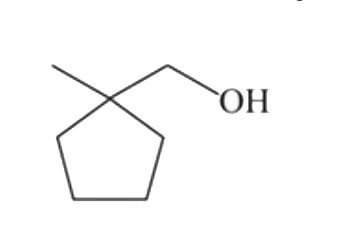Consider the following sequence of reactions :
C6H5CH3Cl2−−→p−ClC6H4CH3NBS−−→(X)Mg−−→(Y)(i)ethylene oxide−−−−−−−−−−→(Z)
Final product (Z) is
p−ClC6H4CH2CH2OH
p−ClC6H4CH2CH2CH2OH
p−(HOCH2CH2)−C6H4CH2Br
p−(HOCH2CH2)−C6H4CH3
The correct Answer is:B
To solve the problem step by step, we will analyze each reaction in the sequence provided and determine the final product (Z).
Step 1: Chlorination of Toluene
- Reaction: Toluene (C₆H₅CH₃) reacts with chlorine (Cl₂).
- Mechanism: Toluene is an aromatic compound with a methyl group (–CH₃) that is ortho-para directing. Chlorination will predominantly occur at the para position due to steric hindrance at the ortho position.
- Product: The major product formed is para-chlorotoluene (p-ClC₆H₄CH₃).
Step 2: Bromination with NBS
- Reaction: para-Chlorotoluene reacts with N-bromosuccinimide (NBS).
- Mechanism: NBS facilitates benzylic bromination, which occurs at the benzylic position (the carbon adjacent to the aromatic ring).
- Product: The product formed is p-ClC₆H₄CH₂Br (compound X).
Step 3: Formation of Grignard Reagent
- Reaction: Compound X (p-ClC₆H₄CH₂Br) reacts with magnesium (Mg).
- Mechanism: The reaction of an alkyl halide with magnesium forms a Grignard reagent.
- Product: The product formed is p-ClC₆H₄CH₂MgBr (compound Y).
Step 4: Reaction with Ethylene Oxide
- Reaction: Compound Y (p-ClC₆H₄CH₂MgBr) reacts with ethylene oxide (C₂H₄O).
- Mechanism: The Grignard reagent acts as a nucleophile and attacks the electrophilic carbon in ethylene oxide, leading to ring opening and formation of a new carbon-carbon bond.
- Product: The product formed is p-ClC₆H₄CH₂CH₂CH₂O⁻MgBr (compound Z).
Step 5: Hydrolysis of the Grignard Reagent
- Reaction: Compound Z undergoes hydrolysis.
- Mechanism: Hydrolysis of the Grignard reagent involves the addition of water (H₂O) to convert the alkoxide into an alcohol.
- Final Product: The final product formed is p-ClC₆H₄CH₂CH₂CH₂OH (compound Z).
Conclusion
The final product (Z) is para-chlorobutanol, specifically p-ClC₆H₄CH₂CH₂CH₂OH.
Answer
The final product (Z) is p-Chlorobutanol.
---
- Reaction: Toluene (C₆H₅CH₃) reacts with chlorine (Cl₂).
- Mechanism: Toluene is an aromatic compound with a methyl group (–CH₃) that is ortho-para directing. Chlorination will predominantly occur at the para position due to steric hindrance at the ortho position.
- Product: The major product formed is para-chlorotoluene (p-ClC₆H₄CH₃).
- Reaction: para-Chlorotoluene reacts with N-bromosuccinimide (NBS).
- Mechanism: NBS facilitates benzylic bromination, which occurs at the benzylic position (the carbon adjacent to the aromatic ring).
- Product: The product formed is p-ClC₆H₄CH₂Br (compound X).
- Reaction: Compound X (p-ClC₆H₄CH₂Br) reacts with magnesium (Mg).
- Mechanism: The reaction of an alkyl halide with magnesium forms a Grignard reagent.
- Product: The product formed is p-ClC₆H₄CH₂MgBr (compound Y).
- Reaction: Compound Y (p-ClC₆H₄CH₂MgBr) reacts with ethylene oxide (C₂H₄O).
- Mechanism: The Grignard reagent acts as a nucleophile and attacks the electrophilic carbon in ethylene oxide, leading to ring opening and formation of a new carbon-carbon bond.
- Product: The product formed is p-ClC₆H₄CH₂CH₂CH₂O⁻MgBr (compound Z).
- Reaction: Compound Z undergoes hydrolysis.
- Mechanism: Hydrolysis of the Grignard reagent involves the addition of water (H₂O) to convert the alkoxide into an alcohol.
- Final Product: The final product formed is p-ClC₆H₄CH₂CH₂CH₂OH (compound Z).
The final product (Z) is para-chlorobutanol, specifically p-ClC₆H₄CH₂CH₂CH₂OH.
The final product (Z) is p-Chlorobutanol.
Similar Questions
Consider the following sequence of reaction. Identify the final product (Y) CH3CH2CH3Cl2/hv−−−→(X)aq.OH−−−−−−→(Y)
View SolutionConsider the following sequence of reaction and identify the final product (Z). CH3−CH=CH2HBr−−→(X)Aq.NaOH−−−−−→(Y)NaOH+l2−−−−−−→(Z)
View SolutionIdentify the final product (Z) in the following sequence of reactions. CH3NH2CH3l Excess−−−−−−−→(X)AgOH−−−→(Y)Δ−−→(Z)+CH3OH
View SolutionThe final product (Z) is the following sequence of reaction CH3CH2NH2HNO2−−−→(X)Socl2−−→(Y) is NH3−−→(Z)
View SolutionIn the following sequence of reaction, the product C is
CH3−BrKCN−−→AH2O+−−−→BLiAlH4−−−→EtherC
View SolutionC6H10NBS−−→(X)Mgether−−−−→(Y)CH3CN−−−−→H3O+(Z)
The compound (Z) is
View SolutionConsider the following sequence of reaction and identify the final product (Z).
CH3CH2CH2BrMg dry ether−−−−−−−→(X)CO2−−→(Y)H+−−→(Z)
View SolutionConsider the following sequence of reactions
C2H5C≡CHCH3MgBr−−−−−→A(1)HCHO−−−−−−→(2)H2O+B
The product (B) is
View SolutionConsider the following sequence of reactions
 H+/Δ−−−−→(X)1.03−−−−−−−−−−→2.Zn/CH3COOH(Y)NaOH−−−→Δ
H+/Δ−−−−→(X)1.03−−−−−−−−−−→2.Zn/CH3COOH(Y)NaOH−−−→Δ 
The intermediate products (X) and (Y) are respectively
View SolutionIdentify the final product in that follow sequence of reactions.
CH2=CH2Br2−−→(X)KCN−−→(Y)H3O+−−−→(Z)
View Solution
